Abstract
Phenolic compounds are widely distributed in the plant kingdom. Plant tissues may contain up to several grams per kilogram. External stimuli such as microbial infections, ultraviolet radiation, and chemical stressors induce their synthesis. The phenolic compounds resveratrol, flavonoids, and furanocoumarins have many ecologic functions and affect human health. Ecologic functions include defense against microbial pathogens and herbivorous animals. Phenolic compounds may have both beneficial and toxic effects on human health. Effects on low-density lipoproteins and aggregation of platelets are beneficial because they reduce the risk of coronary heart disease. Mutagenic, cancerogenic, and phototoxic effects are risk factors of human health. The synthesis of phenolic compounds in plants can be modulated by the application of herbicides and, to a lesser extent, insecticides and fungicides. The effects on ecosystem functioning and human health are complex and cannot be predicted with great certainty. The consequences of the combined natural and pesticide-induced modulating effects for ecologic functions and human health should be further evaluated.
Full text
PDF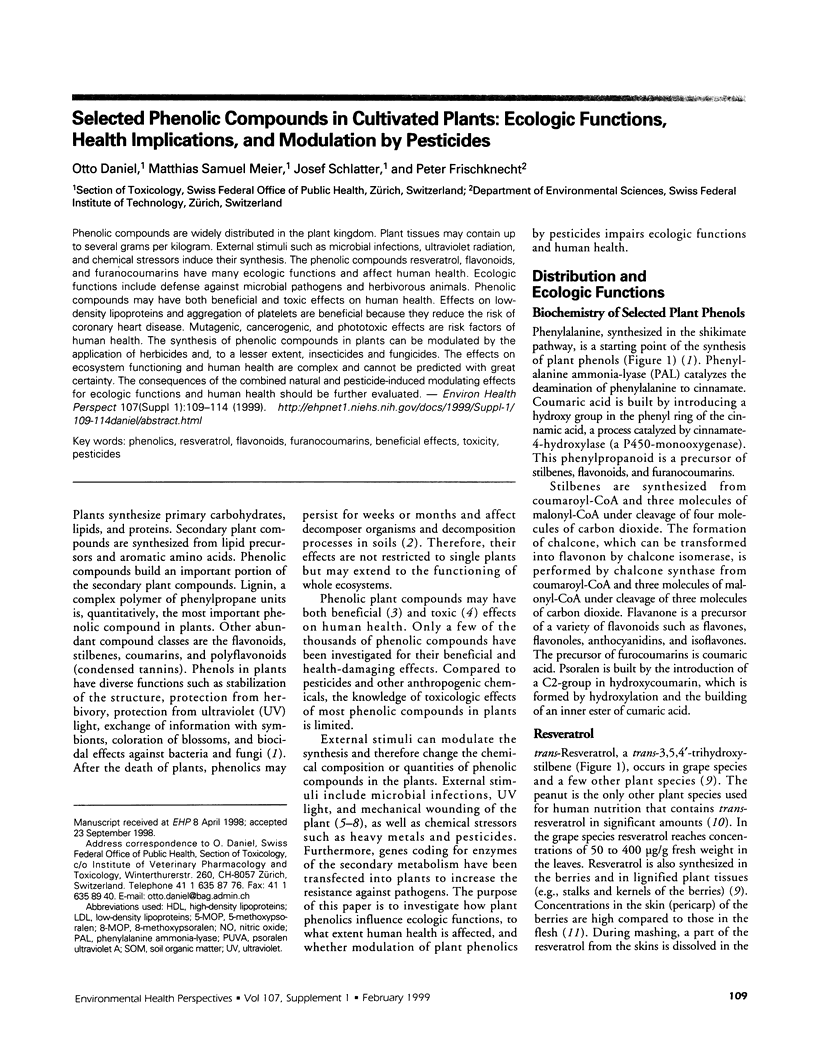
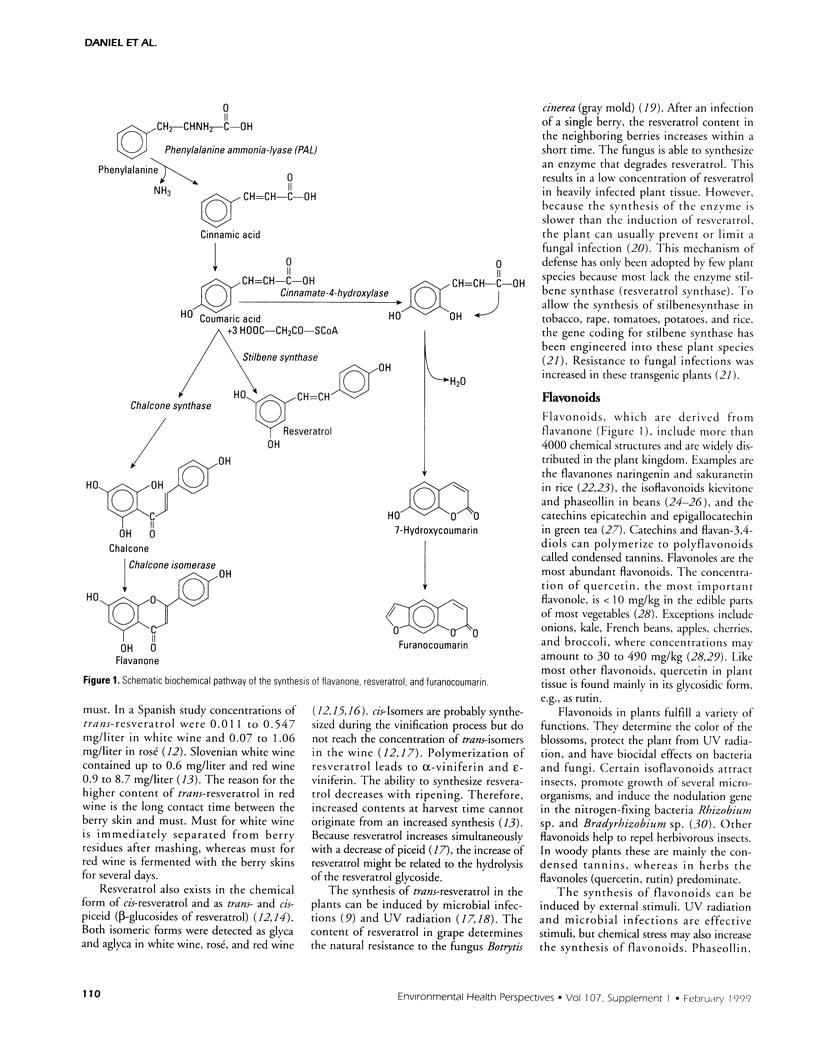
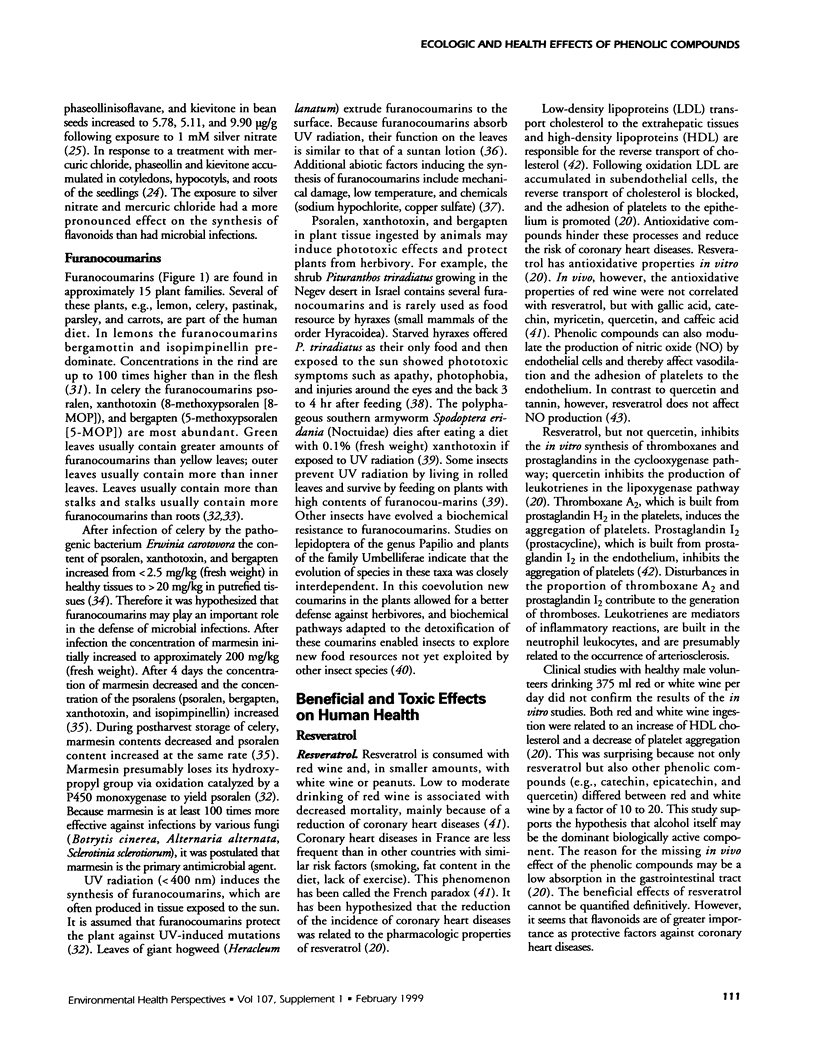
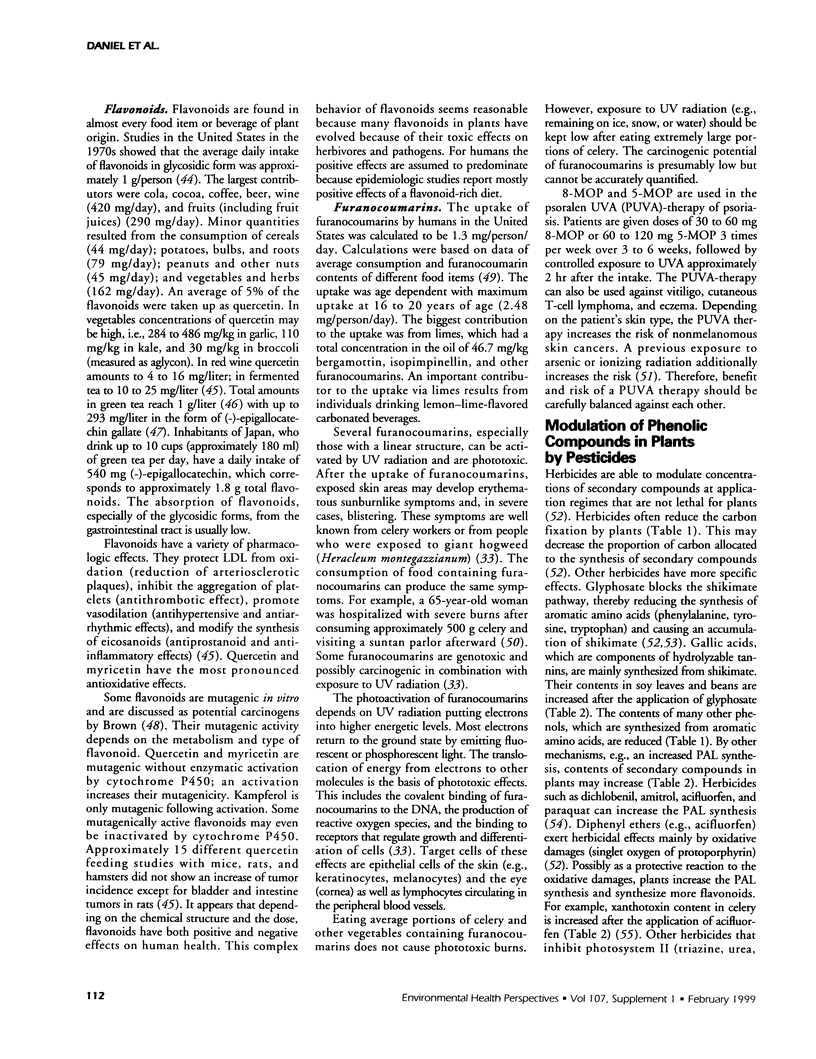
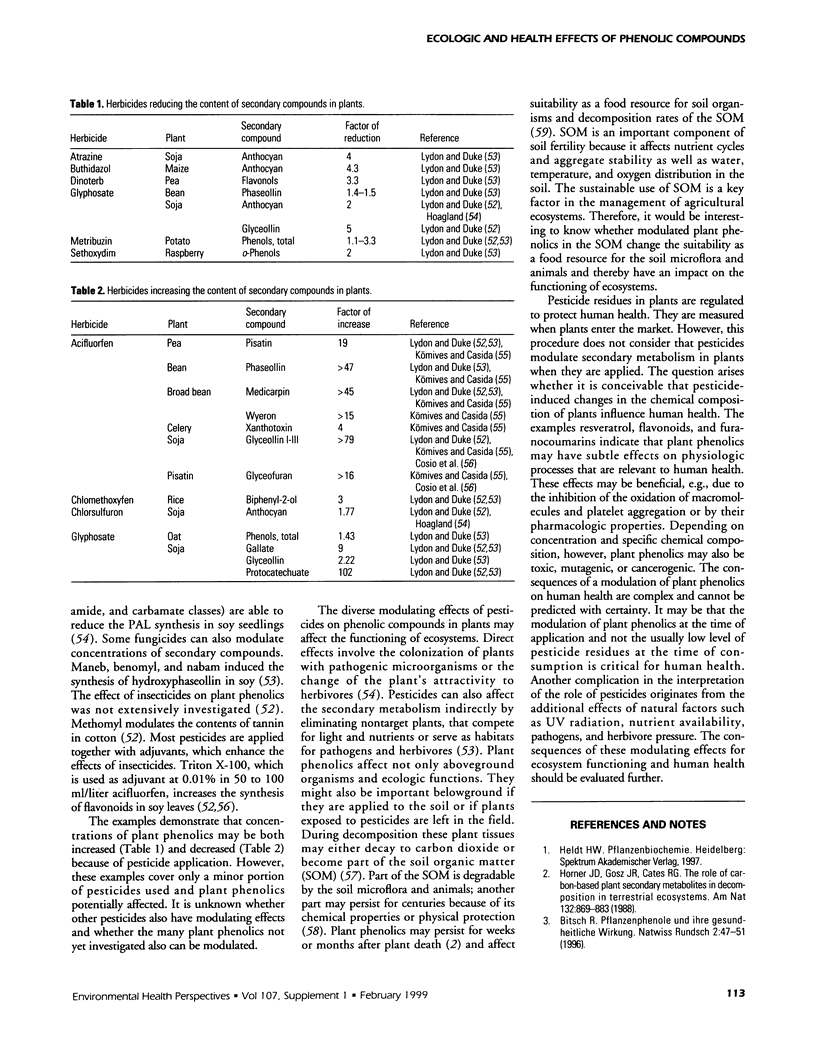
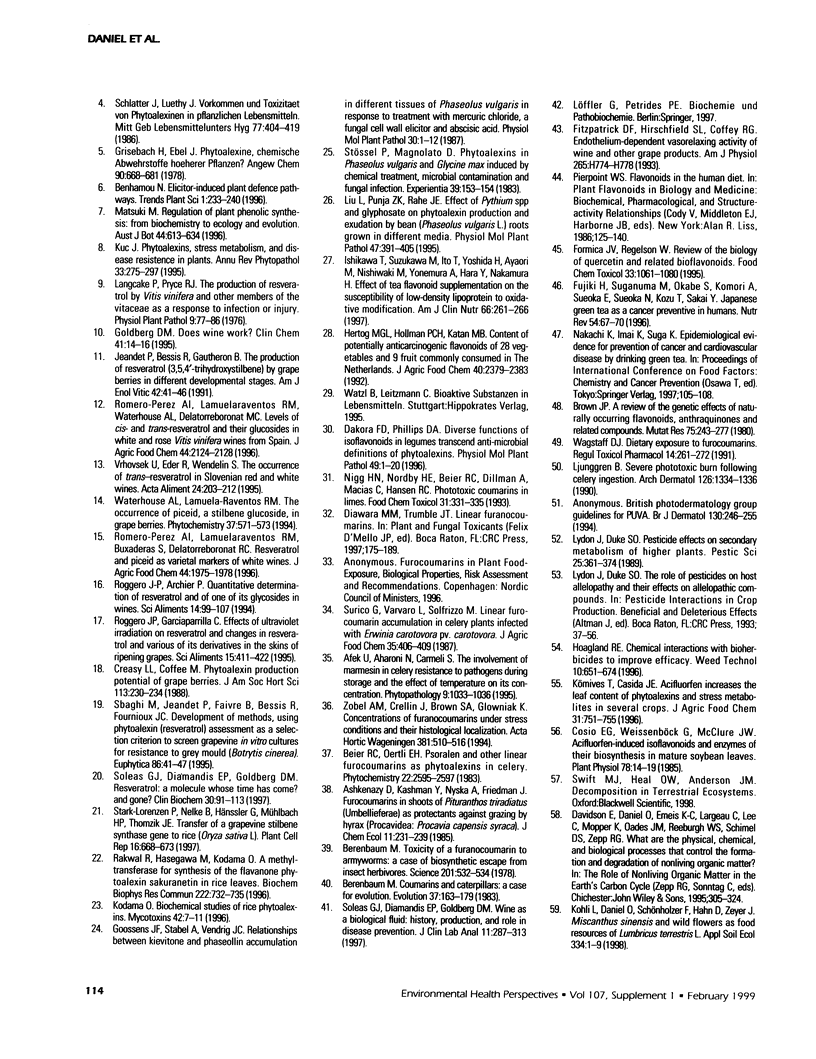
Selected References
These references are in PubMed. This may not be the complete list of references from this article.
- Berenbaum M. Toxicity of a furanocoumarin to armyworms: a case of biosynthetic escape from insect herbivores. Science. 1978 Aug 11;201(4355):532–534. doi: 10.1126/science.201.4355.532. [DOI] [PubMed] [Google Scholar]
- Brown J. P. A review of the genetic effects of naturally occurring flavonoids, anthraquinones and related compounds. Mutat Res. 1980 May;75(3):243–277. doi: 10.1016/0165-1110(80)90029-9. [DOI] [PubMed] [Google Scholar]
- Cosio E. G., Weissenböck G., McClure J. W. Acifluorfen-induced isoflavonoids and enzymes of their biosynthesis in mature soybean leaves : whole leaf and mesophyll responses. Plant Physiol. 1985 May;78(1):14–19. doi: 10.1104/pp.78.1.14. [DOI] [PMC free article] [PubMed] [Google Scholar]
- Fitzpatrick D. F., Hirschfield S. L., Coffey R. G. Endothelium-dependent vasorelaxing activity of wine and other grape products. Am J Physiol. 1993 Aug;265(2 Pt 2):H774–H778. doi: 10.1152/ajpheart.1993.265.2.H774. [DOI] [PubMed] [Google Scholar]
- Formica J. V., Regelson W. Review of the biology of Quercetin and related bioflavonoids. Food Chem Toxicol. 1995 Dec;33(12):1061–1080. doi: 10.1016/0278-6915(95)00077-1. [DOI] [PubMed] [Google Scholar]
- Goldberg D. M. Does wine work? Clin Chem. 1995 Jan;41(1):14–16. [PubMed] [Google Scholar]
- Hegsted D. M. What are American children eating? Implications for public policy (Nutr Rev 1995;53:111-26) Nutr Rev. 1996 Feb;54(2 Pt 1):67–67. [PubMed] [Google Scholar]
- Ishikawa T., Suzukawa M., Ito T., Yoshida H., Ayaori M., Nishiwaki M., Yonemura A., Hara Y., Nakamura H. Effect of tea flavonoid supplementation on the susceptibility of low-density lipoprotein to oxidative modification. Am J Clin Nutr. 1997 Aug;66(2):261–266. doi: 10.1093/ajcn/66.2.261. [DOI] [PubMed] [Google Scholar]
- Ljunggren B. Severe phototoxic burn following celery ingestion. Arch Dermatol. 1990 Oct;126(10):1334–1336. [PubMed] [Google Scholar]
- Lukas J., Groshen S., Saffari B., Niu N., Reles A., Wen W. H., Felix J., Jones L. A., Hall F. L., Press M. F. WAF1/Cip1 gene polymorphism and expression in carcinomas of the breast, ovary, and endometrium. Am J Pathol. 1997 Jan;150(1):167–175. [PMC free article] [PubMed] [Google Scholar]
- Nigg H. N., Nordby H. E., Beier R. C., Dillman A., Macias C., Hansen R. C. Phototoxic coumarins in limes. Food Chem Toxicol. 1993 May;31(5):331–335. doi: 10.1016/0278-6915(93)90187-4. [DOI] [PubMed] [Google Scholar]
- Rakwal R., Hasegawa M., Kodama O. A methyltransferase for synthesis of the flavanone phytoalexin sakuranetin in rice leaves. Biochem Biophys Res Commun. 1996 May 24;222(3):732–735. doi: 10.1006/bbrc.1996.0812. [DOI] [PubMed] [Google Scholar]
- Soleas G. J., Diamandis E. P., Goldberg D. M. Resveratrol: a molecule whose time has come? And gone? Clin Biochem. 1997 Mar;30(2):91–113. doi: 10.1016/s0009-9120(96)00155-5. [DOI] [PubMed] [Google Scholar]
- Soleas G. J., Diamandis E. P., Goldberg D. M. Wine as a biological fluid: history, production, and role in disease prevention. J Clin Lab Anal. 1997;11(5):287–313. doi: 10.1002/(SICI)1098-2825(1997)11:5<287::AID-JCLA6>3.0.CO;2-4. [DOI] [PMC free article] [PubMed] [Google Scholar]
- Wagstaff D. J. Dietary exposure to furocoumarins. Regul Toxicol Pharmacol. 1991 Dec;14(3):261–272. doi: 10.1016/0273-2300(91)90029-u. [DOI] [PubMed] [Google Scholar]


